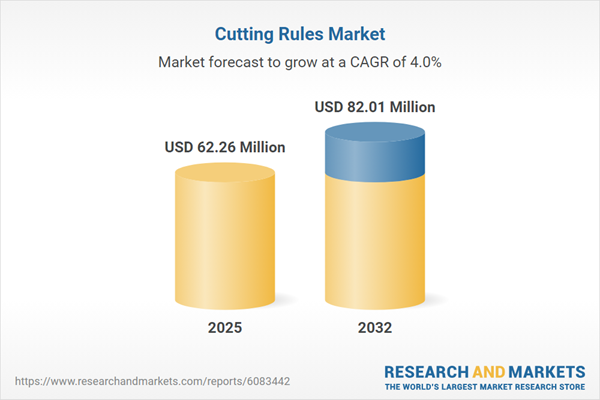Speak directly to the analyst to clarify any post sales queries you may have.
The Cutting Rules Market is experiencing substantial transformation as senior decision-makers navigate increasing production complexity, material innovation, and evolving client demands. As agility and technology integration become central to operations, understanding the key drivers and dynamics of this sector is essential for sustainable market leadership.
Market Snapshot: Cutting Rules Market Outlook
The Cutting Rules Market posted steady growth, expanding from USD 59.83 million in 2024 to USD 62.26 million in 2025. The market is projected to reach USD 82.01 million by 2032, supported by a CAGR of 4.02%.
This trajectory signals robust demand for advanced cutting solutions across diverse manufacturing applications, driven by the adoption of higher-precision technologies, the broadening range of materials in the production process, and heightened requirements from industrial buyers worldwide.Scope & Segmentation Overview
This comprehensive market analysis provides senior leaders with clear segmentation and strategic insights, addressing procurement behaviors, technology adoption, and innovation trends shaping the global cutting rules landscape.
- Product Type: The report covers an array of solutions encompassing both standard and advanced cutting rules. These include adaptable feature types as well as next-generation models designed for high-precision tasks, supporting a wide spectrum of manufacturing requirements.
- End User: Insights extend to all major consumer groups, distinguishing needs across household and individual users, alongside enterprises from large organizations to SMEs. This differentiation supports targeted strategies aligned with specific operational environments.
- Distribution Channel: Procurement pathways span traditional offline outlets—carrier and retail stores—as well as digital platforms, including e-commerce and manufacturer-specific portals. The diversity in channels underscores the sector’s evolving approach to reach and service delivery.
- Regional Coverage: The report details market activity and opportunity across key regions: Americas, Europe, Middle East & Africa, and Asia-Pacific. Each area presents unique regulations, infrastructure maturity, and innovation ecosystems, underscoring the value of tailored market entry and growth strategies.
- Key Companies: Analysis includes benchmarking against established leaders such as Lawton Rule Precision Manufacturing Co., Inc., Sheihom Rule Company, TKS Rule Die Service Co., Ltd., Felins North America LLC, Draco Machine & Tool, Inc., and other prominent manufacturers, highlighting best practices and innovation strengths.
Key Takeaways for Senior Decision-Makers
- Technological advancements, including artificial intelligence and machine learning, are now embedded in leading solutions, enhancing both automation and operational safety for users.
- There is a growing focus on modular designs and circular economy practices, with industry leaders adopting recycled materials and strategies to extend product usability in response to environmental and regulatory priorities.
- Customer preferences are shifting toward individualized service models. Many buyers now seek tailored solutions, ongoing lifecycle support, and options such as subscription-based offerings to ensure continuous improvement.
- Strategic alliances between device manufacturers, telecom partners, and software developers are contributing to market differentiation, as premium features and collaborative innovations reshape the competitive landscape.
- Procurement priorities differ by segment: large organizations emphasize holistic cost of ownership, while small and medium-sized firms and residential segments favor operational flexibility and productivity gains.
- Regionally specific regulations and infrastructure maturity demand adaptable business models, supporting risk management and sustained growth in both established and emerging markets.
Tariff Impact and Supply Chain Realignments
Recent tariff changes in the United States require market participants to reconsider their manufacturing and sourcing strategies. Companies are increasingly turning to near-shoring, which diversifies supply networks and boosts domestic inventories. While these adjustments enhance overall supply chain resilience, they introduce added complexity in logistics and heighten the need for advanced digital supply chain management tools and robust data visibility solutions to ensure quality and flexibility.
Methodology & Data Sources
This report is built on a multi-phase research framework, combining direct interviews with industry leaders, analysis of authoritative secondary sources, and systematic review of official filings. Quantitative triangulation and expert workshops support the credibility and operational relevance of findings, with data validation at each research stage to secure actionable insight for executives.
Why This Report Matters
- Provides deep segmentation and actionable insights to craft targeted go-to-market strategies, supporting investment and operational alignment across all key customer groups.
- Supports strategic leadership with foresight into regulatory shifts and technology adoption, helping decision-makers maintain agility in dynamic market conditions.
- Delivers a framework to manage increasing supply chain complexity and tariff-related uncertainty, safeguarding business continuity and improving long-term profitability.
Conclusion
In an evolving Cutting Rules Market, executives who proactively adapt to changes in regulations, technology, and supply networks will reinforce their competitive stance and seize new growth opportunities as industry boundaries continue to shift.
Table of Contents
3. Executive Summary
4. Market Overview
7. Cumulative Impact of Artificial Intelligence 2025
Companies Mentioned
The companies profiled in this Cutting Rules market report include:- Lawton Rule Precision Manufacturing Co., Inc.
- Sheihom Rule Company
- TKS Rule Die Service Co., Ltd.
- Felins North America LLC
- Draco Machine & Tool, Inc.
- Die Supplies, Inc.
- Precision Rule Co., Ltd.
- Brunger Industries, Inc.
- Flexo Tools, Inc.
- E & J Manufacturing, LLC
Table Information
| Report Attribute | Details |
|---|---|
| No. of Pages | 186 |
| Published | October 2025 |
| Forecast Period | 2025 - 2032 |
| Estimated Market Value ( USD | $ 62.26 Million |
| Forecasted Market Value ( USD | $ 82.01 Million |
| Compound Annual Growth Rate | 4.0% |
| Regions Covered | Global |
| No. of Companies Mentioned | 11 |









